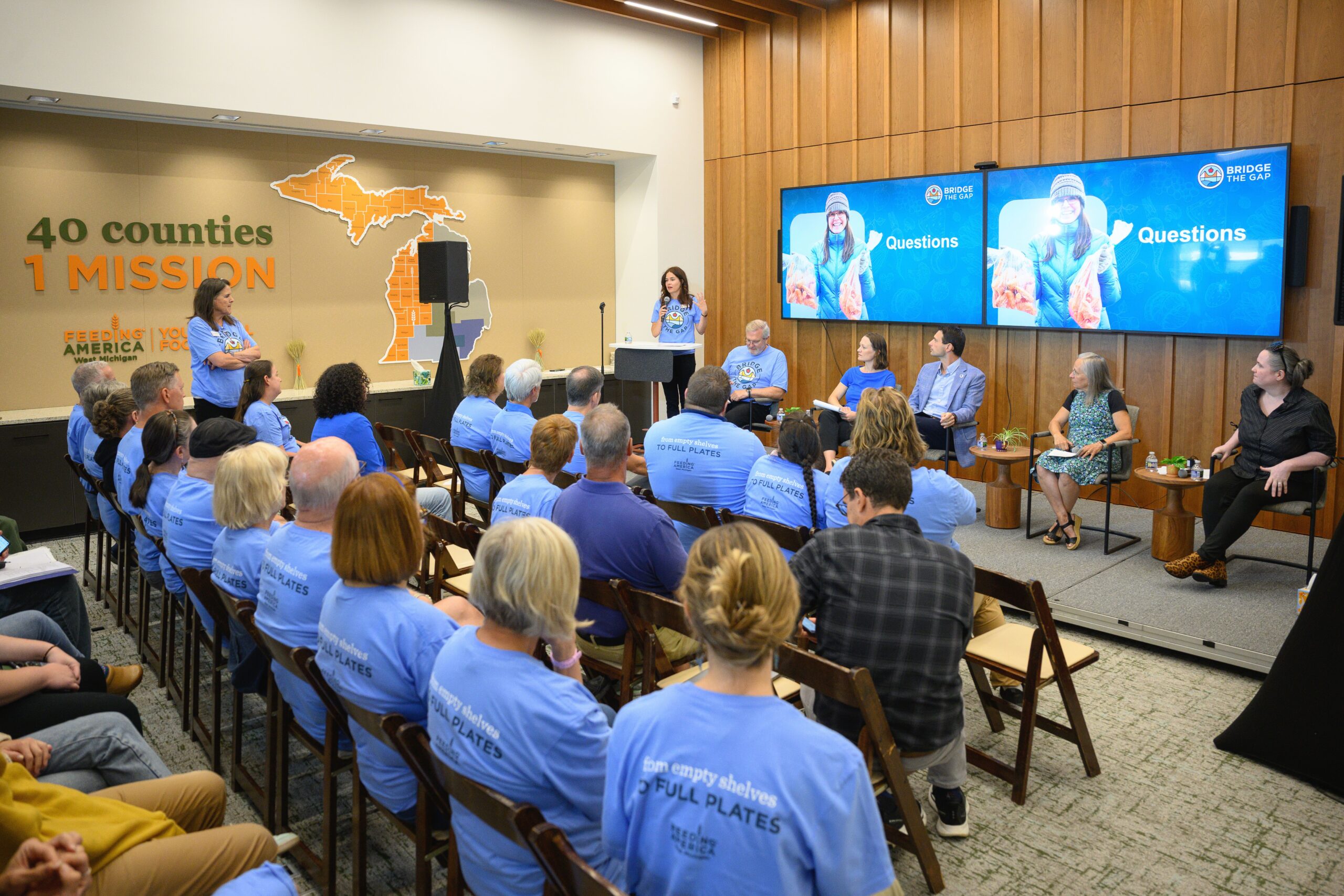
Town hall kicks off awareness and fundraising campaign to prepare for increased demand
Feeding America West Michigan is facing a “perfect storm” of challenges. Demand for food is the highest ever in the organization’s history, yet thousands more Michiganders are expected to turn to food pantries for help next year. Demand is expected to go up at the same time federal support for food banks has been trimmed.
Unprecedented demand and shrinking resources will place tremendous strain on the local food bank, as well as food banks throughout the United States.

“What we’re calling it is the perfect storm,” said Ken Estelle, Feeding America West Michigan president and CEO, speaking at a virtual town hall meeting today. “It’s where we have unprecedented need, food cancellations, and we’re also looking at assistance changes in food assistance programs… We’re expecting at least 50,000 more neighbors needing help as a result of these policy changes. Based on that, we looked at our food insecurity rate going to 16.4%, which is the highest food insecurity rate we’re ever experienced in our service area.”
The food bank hosted a virtual town hall-style panel discussion to kick off Bridge the Gap, a campaign to prepare for looming changes. Town hall panelists shared the impact of pending federal changes on health, retailers, local service agencies and the families that depend on food pantries to help them.
Panelists also spoke about the economic conditions behind the current spike in demand for charitable food from local agencies. They discussed the expected spike in demand next year when tightened eligibility will push people off of the Supplemental Nutrition Assistance Program (SNAP) and Medicaid.
“One of the biggest changes to SNAP is more stringent work requirements,” said Anna Fischer, Director for Healthy Communities Policy at Public Policy Associates in Lansing. “People are expected to stay in the workforce up to age 64 instead of 54 and families with children aged 14-17 will also be expected to stay in the workforce and meet certain work requirements. So there are real risks with older adults and our families with teens.”
Long-time TriCities resident Amanda participated on the panel to speak about the importance of having healthy nutritious food through Feeding America West Michigan programs. Living on a fixed income, she has turned to Love In Action in Grand Haven for food for her family. Through the agency, she has found support, community connections, and friendships that she didn’t imagine were possible.

“Because of the type of food that Feeding America provides, the improvements to our physical health have been tremendous and beyond what I thought we’d be capable of,” she said. “I take less medication than I have in 15 years. My husband, who is older than me, takes zero medication. We’ve developed a food culture in our family that wasn’t there before. We are more productive and active at work, at home, and in our community. We have a sense of restored hope where we have been able to take back our dignity and our belief of what we are capable of.”
Agency partners expresses there is hope in community
Despite the challenges, panelist Cheryl Youngquist, Director of Operations at Love In Action in Grand Haven, also spoke to the hope found in community.
“There’s a lot of concern for the ‘what-if’,” she said. “Not knowing if the programs we’ve relied on will continue. It is a hard time, it’s a stressful time. I had a woman that met me in the parking lot the other day and she said, ‘If we look at what we have and share what we can, we will get through this.’ We just all need to keep working in community.”
SNAP and Michigan’s retail economy
Drew Beardslee, Vice President of Government Affairs at Michigan Retailers Association, underscored the importance of SNAP dollars in fueling the state economy, with every dollar of SNAP dollars spent generating up to $1.80 in economic activity.

“There are about 10,000 SNAP-authorized retailers in the state doing about $3.6 million worth of SNAP redemption in those locations,” he said. “That encompasses a wide diversity of retail stores, from your larger stores and chains from your small and independent operations. For the retailers, we’ve seen that SNAP can drive customers to stores. When there’s a lot of turbulence in the economy, a lot of uncertainty, SNAP can be a more dependable revenue for retailers.”
How will we bridge the gap?
In addition to spurring everyone in our community to understand the issues and volunteer at local food-assistance agencies, the food bank hopes to raise $1.5 million to focus on three things:
- Replacing lost federal funds for purchasing food, including food from local farmers.
- Assisting local agencies that run pantries with their capacity to help more neighbors.
- Operational costs for warehousing and transportation costs.
“The campaign will allow us to get the food that we need to be able to continue to meet the need that is there today and will be growing even more than what we’re currently seeing,” Estelle said. “Ultimately, it really means our ability to be able to supply the food that our neighbors need through the next year.”
Thank you to everyone who attended our Bridge the Gap both virtually and in person. Visit our dedicated webpage to read more about our campaign and learn how you can help bridge the gap.

